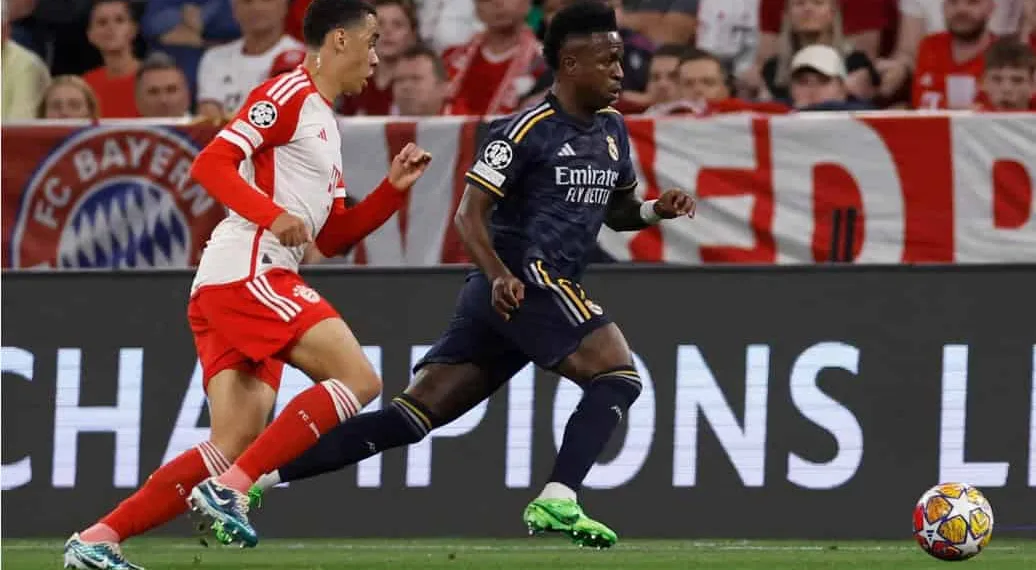At the stroke of midnight on Wednesday, the Allianz Arena became the stage for a thrilling clash between two European football giants, each striving for a slight edge in their quest for the final showdown at Wembley.
The semi-final showdown of the Champions League pitted Bayern Munich against Real Madrid, promising a spectacle after both teams narrowly triumphed over English opponents in the previous round. The strategic duel between Thomas Tuchel and Carlo Ancelotti was enthralling, resulting in a fiercely contested match marked by flashes of brilliance and questionable decision-making, epitomizing the intensity and drama of the occasion.

Real Madrid showcased their attacking prowess, demonstrating their ability to dismantle defenses through creative and unconventional play, posing constant challenges for Bayern’s backline. Nevertheless, the home team retaliated with their own arsenal of dynamic playmakers and tactical adjustments orchestrated by a manager well-versed in navigating the Champions League’s latter stages. Despite Bayern taking an early lead, they were swiftly equalized by yet another moment of brilliance from Vinicius Junior, who has established himself as a standout performer on such crucial European nights.
As the tie hangs in the balance ahead of the return leg in Madrid next week, both Bayern and Real will dissect the key moments of the match and strive to address any vulnerabilities to potentially face Borussia Dortmund or PSG in the final. This tactical analysis aims to delve into the pivotal moments of the encounter, shedding light on how each team exploited the other’s weaknesses. By examining the tactics employed by both sides, we aim to illustrate their effectiveness both in possession and out of it.
Read More: Kai Havertz: The Journey from Chelsea Misfit to Arsenal’s Big Game Man
Bayern Munich and Real Madrid’s Starting Line-ups
Bayern Munich opted for their customary 4-2-3-1 setup, with Manuel Neuer guarding the goal. The defensive line featured Mazraoui, Dier, Kim Min-Jae, and captain Joshua Kimmich, stationed as the right back. Just ahead of them, Leon Goretzka and Konrad Laimer formed the double pivot, balancing offensive and defensive responsibilities adeptly. Musiala and Sané were tasked with creating havoc on the flanks, while Thomas Müller and Harry Kane were assigned to engage Madrid’s defenders centrally.

Meanwhile, the visiting Real Madrid continued with Ancelotti’s preferred 4-4-2 diamond formation, showcasing their tactical versatility and knack for generating scoring opportunities. Andriy Lunin retained his place in goal, with Thibaut Courtois still sidelined due to injury.
The defensive quartet remained unchanged, comprising Mendy, Rüdiger, Nacho, and Lucas Vázquez, filling in for the suspended Carvajal. In midfield, the lineup consisted of Toni Kroos, Federico Valverde, Aurelien Tchouaméni, and Jude Bellingham, offering a blend of experience and youthful energy. Leading the attacking line were the dynamic duo of Rodrygo and Vinícius Junior, with Bellingham and Rodrygo occasionally swapping positions during the game.
Tactical Brilliance in Bayern Munich’s Attack: Showing Variability
Bayern Munich immediately asserted their dominance in the fixture, largely due to Thomas Tuchel’s astute setup aimed at exploiting the entire final third. The crucial role of Bayern’s double pivot became apparent in their build-up play, as Laimer and Goretzka’s movement often confounded the marking of Real Madrid’s forwards.
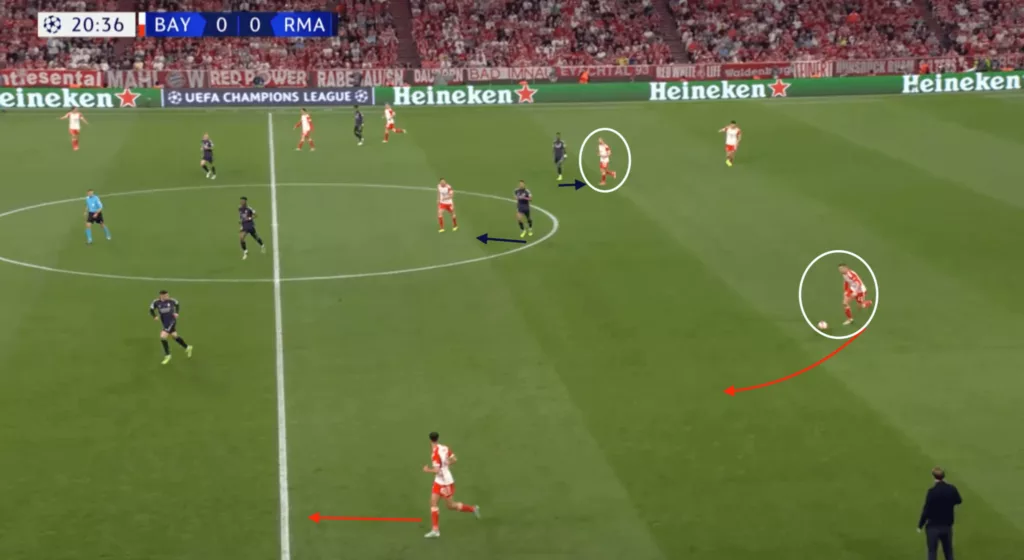
By maintaining varied positioning, with Goretzka often pushing forward, Bayern forced Madrid’s high defensive line to make difficult decisions between pressuring the midfield or the center backs. This confusion allowed players like Laimer to drop back, creating numerical advantages on one side of the pitch while leaving space for the central defender and wing-back on the opposite flank. For instance, Eric Dier could exploit the left flank while Madrid scrambled to readjust their defensive shape after being pulled towards the opposite side.
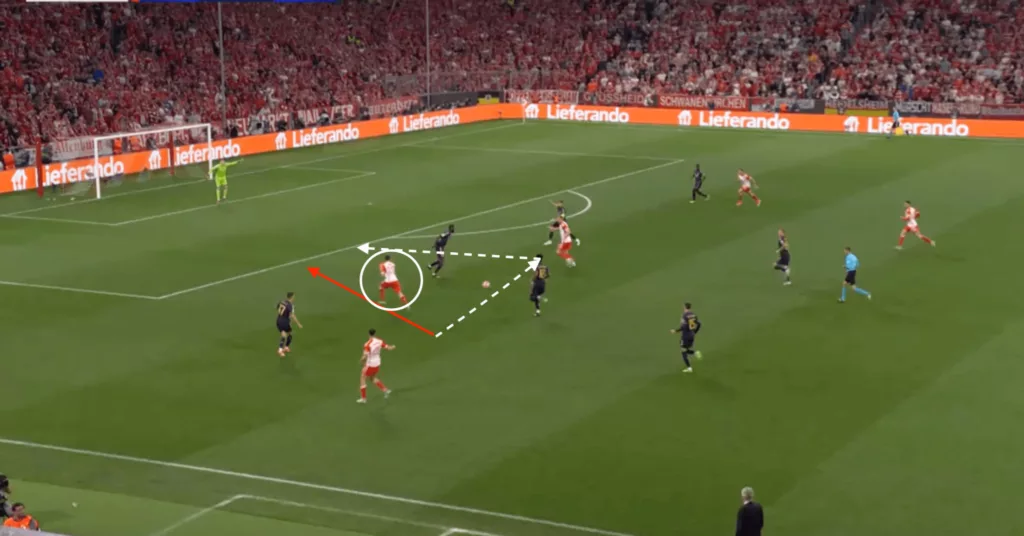
Meanwhile, with Mazraoui and Kimmich providing width higher up the flanks, Bayern posed an immediate threat. Musiala and Sane had the freedom to drift inside to the half-spaces, allowing them to play closer to Müller and Kane and facilitate crucial interchanges to penetrate the defensive lines. This flexibility was evident when Rüdiger found himself torn between tracking Sane’s run or granting Kane space at the edge of the penalty area, ultimately leading to an early scoring opportunity for the German winger.
Tuchel’s Tactical Masterstroke
Despite Bayern’s initial attacking endeavors proving futile and Real Madrid taking the lead into halftime, Tuchel orchestrated a pivotal change that swung the momentum back in Bayern’s favor. The decision to swap positions between Musiala and Sané allowed them to capitalize on their stronger foot while driving towards the center of the pitch. However, Tuchel’s halftime substitution arguably had an even greater impact.

Introducing Guerreiro for Goretzka shifted Bayern to a 4-3-3 formation in possession, with Konrad Laimer assuming the role of the lone pivot after an outstanding defensive display. This adjustment prompted Müller to drop deeper, forming a dynamic duo with Guerreiro as the advanced central midfielders, thereby posing additional challenges for Madrid in the midfield battle. By stretching Madrid’s narrow defensive line, Bayern found more space to exploit out wide.

This tactical shift played a crucial role in both of Bayern’s goals. Müller’s adept manipulation of Madrid’s defensive line created a clear 1v1 opportunity for Sané, who capitalized by cutting inside and finding the back of the net past Lunin. Meanwhile, Guerreiro’s intelligent off-the-ball movement between Rüdiger and Vázquez created ample space for Musiala on the left flank, leading to the Madrid full-back conceding a penalty in a desperate attempt to thwart the danger.
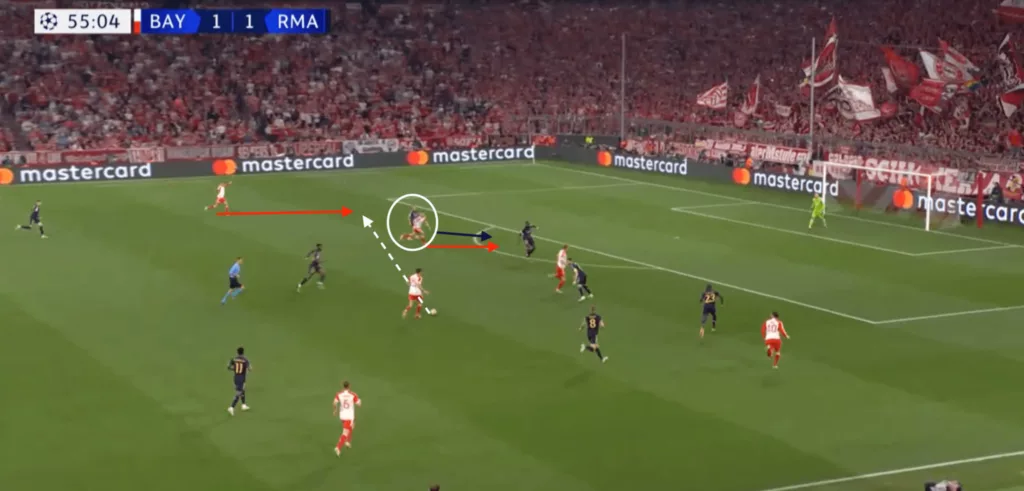
Real Madrid’s Tactical Adaptation
After withstanding Bayern’s early onslaught, Ancelotti’s squad gradually asserted themselves in the match, implementing crucial defensive adjustments that curtailed the influence of Bayern’s playmakers. During Bayern’s initial dominance, Real Madrid’s defensive lines were stretched too thin, leaving gaping spaces for Sane to exploit, while Harry Kane dropped deeper to link play.
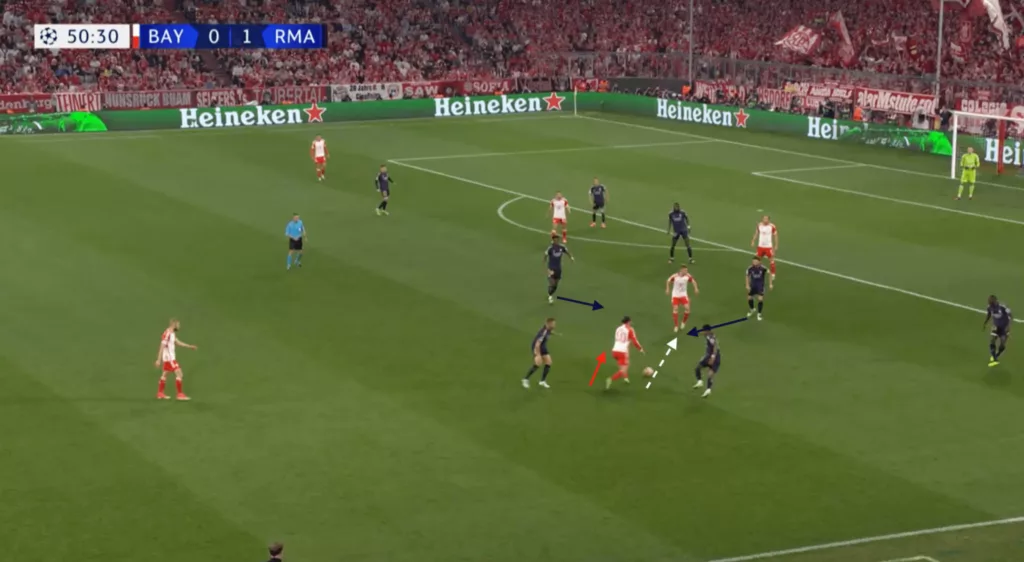
To counter this, Kroos and Tchouaméni tightened their positioning, sticking closer to the defensive line to limit Bayern’s attacking freedom and restrict space. Real Madrid managed to achieve this without sacrificing their threat on the counter-attack, allowing them to stifle Bayern’s play and initiate rapid transitions.
In attack, the movement of Madrid’s midfielders was pivotal in breaking down Bayern’s defense. With the full-backs pushing high and wide, Kroos dropped deeper to receive the ball and shifted across to cover the vacant spaces on the flanks. This strategic adjustment enabled him to act as the deep-lying playmaker, eventually unlocking Bayern’s defense for the opening goal.

The movements of Bellingham and Tchouaméni were also instrumental in Madrid’s breakthrough, particularly in creating space for the crucial pass between Kroos and Vinícius Jr. Tchouaméni’s forward run drew Konrad Laimer, opening up the passing lane for Kroos to find Vinícius Jr. Meanwhile, Bellingham’s presence in the final third distracted Kim Min-Jae, allowing Vinícius Jr. to gain an advantage. The subsequent defensive scramble proved futile, as Vinícius Jr. calmly slotted the ball into the bottom corner.
Reckless Defending Haunts Bayern
Kim Min-Jae found himself under scrutiny as the culprit for both of Real Madrid’s goals, reflecting a night of overly aggressive defending from Bayern’s back line. In a match with significant implications for the season, Bayern’s central defensive pairing seemed to succumb to the pressure of the occasion. Kim’s positional lapses failed to anticipate the intricate play between Madrid’s Brazilian forwards, leading to his desperate foul on Rodrygo in the penalty area.

Bayern narrowly escaped further punishment, as their center-backs attempted to press high and restrict space for Madrid’s attackers. However, Eric Dier’s aggressive attempt to win an aerial duel against Valverde left him exposed, allowing Bellingham to exploit the vacated space. This nearly resulted in a penalty for Madrid after a last-ditch foul by Mazraoui.
The decision to adopt an aggressive stance may have stemmed from the noticeable gap between Bayern’s double pivot and their central defenders, as evidenced in Madrid’s opening goal. This forced Kim to step up and press, but his timing was off, leading to his foul on Rodrygo. While Kim’s interception of Tchouaméni’s pass and subsequent swift counterattack showcased early success, it also highlighted a lack of maturity and recognition of the opposition’s threat. Unfortunately, this realization came too late for Bayern, as they found themselves trailing before making necessary adjustments.
Strategic Adjustments Ahead of the Second Leg
As the focus shifts to the upcoming clash in Madrid, the scales tip in favor of the home team, with Bayern perhaps ruing missed opportunities as the tie stands at 2-2. The first leg showcased the key elements for success for both sides, but there are areas where adjustments can be made to enhance effectiveness in this crucial encounter.
Transitional play emerged as a decisive factor for both teams, with Bayern initially struggling to contain the dynamic Madrid forward line. Vinícius, in particular, repeatedly exploited space behind Bayern’s defense, highlighting the need for Bayern to minimize gaps in their defensive setup. This could be achieved by Neuer adopting a slightly higher position or by the Bayern defenders exercising caution in their pressing, opting instead for a more disciplined defensive approach to withstand Madrid’s attacking onslaught.

While Madrid enjoyed success in their attacking transitions, the defensive contribution of their forwards must improve to thwart Bayern’s offensive threats effectively. Despite Bellingham’s potential fitness concerns, Vinícius must match his defensive efforts with his attacking prowess to prevent Bayern’s midfield from dictating play. As observed in the first leg, Vinícius’s failure to track Laimer allowed the Austrian midfielder to advance and set up Sane for Bayern’s opening goal. Improving defensive diligence from the Madrid forwards will be crucial in neutralizing Bayern’s attacking moves and gaining the upper hand in the pivotal second leg.

